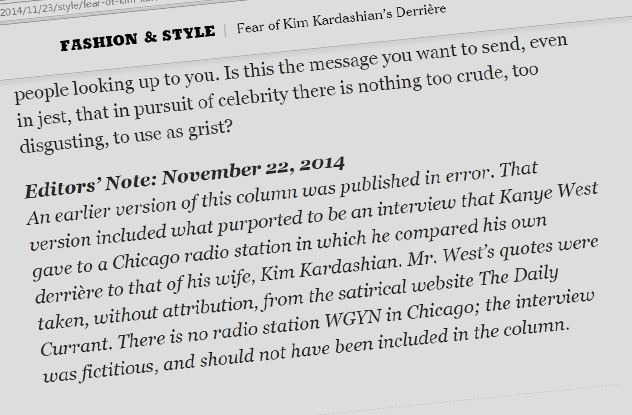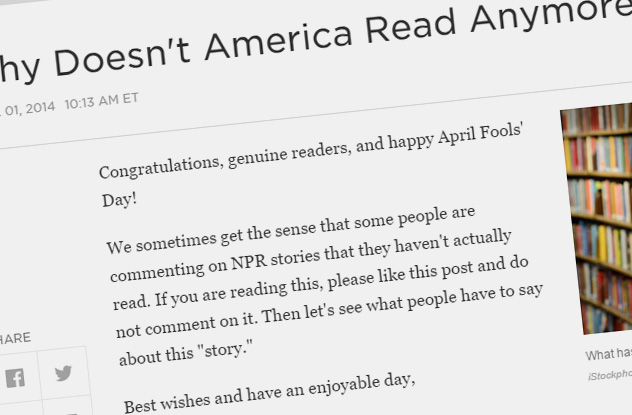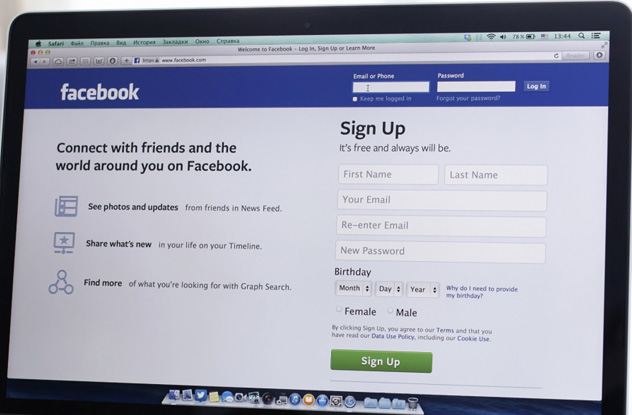 Weird Stuff
Weird Stuff  Weird Stuff
Weird Stuff  Animals
Animals 10 Inspiring Tales of Horses Being Human
 Mysteries
Mysteries Top 10 Haunting Facts About the Ghost Ship MV Alta
 History
History 10 Surprising Stories About the Texas Rangers
 Humans
Humans 10 Philosophers Who Were Driven Mad by Their Own Theories
 Miscellaneous
Miscellaneous 10 Video-Game-Worthy Weapons and Armors from History
 Weird Stuff
Weird Stuff 10 Psychics Who Accurately Predicted Wartime Events
 The Arts
The Arts 10 Pieces of Art Inspired by a Broken Heart
 Health
Health 10 Science Fiction-Sounding New Medical Treatments
 History
History 10 Surprising Facts About the Father of Submarine Warfare
 Weird Stuff
Weird Stuff 10 Times Real Laws Were Based on Bizarre Hypotheticals
 Animals
Animals 10 Inspiring Tales of Horses Being Human
 Mysteries
Mysteries Top 10 Haunting Facts About the Ghost Ship MV Alta
Who's Behind Listverse?

Jamie Frater
Head Editor
Jamie founded Listverse due to an insatiable desire to share fascinating, obscure, and bizarre facts. He has been a guest speaker on numerous national radio and television stations and is a five time published author.
More About Us History
History 10 Surprising Stories About the Texas Rangers
 Humans
Humans 10 Philosophers Who Were Driven Mad by Their Own Theories
 Miscellaneous
Miscellaneous 10 Video-Game-Worthy Weapons and Armors from History
 Weird Stuff
Weird Stuff 10 Psychics Who Accurately Predicted Wartime Events
 The Arts
The Arts 10 Pieces of Art Inspired by a Broken Heart
 Health
Health 10 Science Fiction-Sounding New Medical Treatments
 History
History 10 Surprising Facts About the Father of Submarine Warfare
10 Insane Ways The Online Media Is Lying To You
Right now, you have more information at your fingertips than 99 percent of history’s scholars. With a swipe of your finger, you can wire yourself into thousands of unfolding news stories, read books written centuries ago, or keep up to date with the latest scientific findings. Not just you, but everyone reading this and billions of other people, too. It’s learning on an unprecedented scale.
Or it would be if the Internet didn’t excel at spreading nonsense. As you read this, hundreds of websites are making millions of dollars reprinting absurd, damaging, and confusing lies, adding to the overall dumbness in the world. Here’s how.
10Incredible Unsourced (Or Badly Sourced) Stories 10 Insane Ways The Online Media Is Lying To You
Phony stories thriving on social media
Sources or it didn’t happen. That’s the one rule of thumb when reading something on the Internet. If a site presents you with “10 Amazing History Facts” and one of them is, say, “Hitler injected himself with bull semen,” they better have a hyperlink immediately afterward to a reputable site confirming the story. The emphasis there is on “reputable.” Although most sites now take care to source their claims, many do so by linking to sources that are less than useless.
The worst offender is The Daily Mail. Because it looks like a real news site written by real journalists, thousands of blogs and aggregators get stories from it. In reality, most of what they’re reprinting is utter bunkum. The Mail have a track record of making stories up, something that frequently gets them into hot water with the UK’s Press Complaints Commission. Yet American sites keep linking to them. The Huffington Post, CBS, and Time all reprinted the Mail’s made-up story about Beijing screening fake sunrises during heavy pollution. Nastier outlets simply reprint the Mail’s worst race-baiting headlines to give their hatred a sheen of legitimacy (even when the headlines are demonstrably false).
This doesn’t stop with the Mail. Many sites still source their facts from laughably disreputable places like Breitbart, RT, Press TV, the National Record, the Examiner, Wikipedia, or even know-nothing content mills like eHow.
9Legitimate Sources That Have Legitimately Messed Up

On November 22, 2014, the New York Times was forced to issue a humiliating clarification. They’d quoted an interview Kanye West gave to WGYN in Chicago, comparing his own backside with that of his wife. Unfortunately, there’s no such station as WGYN. The story came from The Daily Currant, a satirical site that posts articles with headlines like “bestiality surges following gay marriage legalization.”
The point is that if even the venerable New York Times can be fooled into printing fake stories, what hope do the rest of us have? While the Times should have done a fact-check, things get even murkier when a seemingly legitimate source slips up. In 2011, the BBC ran a headline about a dog being sentenced to death by stoning in Israel. They’d gotten their information from the AFP, another legitimate source. It turned out the whole thing was completely false, but because both the BBC and AFP were saying it was true, other outlets ran with it.
One of the Internet’s favorite weird facts for a long time was how a miscalculation of the iron value of spinach indirectly led to the creation of Popeye. Because it came from the British Medical Journal, this was run as a genuine crazy fact by major sites. It later transpired the article in question came from the BMJ’s notorious Christmas issue, where they publish amusing and made-up studies.
8Unbelievable Headlines

Going by the headlines, 2015 has been a scary year for news. Did you know that Obama just seized over one million acres of federal land? Or that hand sanitizer has been proven to make you absorb emasculation chemicals that feminize men?
As a discerning reader (you’re here, after all), you can probably guess those headlines aren’t telling the whole truth. But millions of readers can’t. Both those articles come from NaturalNews.com, a site that pulls in over seven million unique(ly gullible) readers each month by printing outrageous headlines that pander to their prejudices. That’s not to say their stories are made-up. They’re usually based in fact. But the headlines deliberately spin them as far from the truth as they possibly can.
For instance, the Obama headline above relates to the president recently declaring three new national monuments, totaling around one million acres. The hand sanitizer one refers to a study that found using certain skincare products before handling thermal paper cash register receipts can result in the body absorbing BPA—a chemical designed as an estrogen supplement. Neither of those stories is what you’d take from glancing at the headline, which is exactly the point. An outrageous headline gets outraged clicks and outraged shares, pushing up traffic for the outrageous liars who wrote it.
That’s why you so frequently see stuff popping up in your Facebook feed that sounds unbelievable. There are entire websites dedicated to churning out screaming headlines that stoke fear and hatred and get shared widely enough to make money. Scarily, many get more traffic than actual, legitimate news sites.
7Outdated Information

Even when websites source their facts perfectly, they can still end up inadvertently lying to you. Here at Listverse, we’ve been putting out between one and three lists a day since June 30, 2007. Some of our most popular articles were written over half a decade ago, and plenty of the old lists still get some hefty traffic. The only problem is, those old lists are no longer strictly accurate. Like a lump of uranium, several of the facts in them have decayed away.
It’s called the half-life of facts, and it affects every long-running site out there. Human knowledge is constantly being superseded by new stuff. If we go back far enough, nearly everything people believed (the Earth being flat, germs being spread by good hygiene, women’s wombs wandering about their bodies) we now know to be wrong. So some scientists decided to measure the rate at which knowledge decays. They found it’s possible to perfectly predict the half-life of facts in many fields. Math has an extremely long half-life. Medicine and the social sciences, on the other hand, have extremely short ones.
As a result, a great deal of what’s written on the older pages of facts sites is no longer considered true. British quiz show QI estimated that around 60 percent of the “facts” in its first season (broadcast in 2003) have now decayed into lies. That’s not such an issue if you’re staying up to date, but if you’re one of those people who likes to browse the archives, bear in mind a lot of what you’re reading has long ago been superseded.
6‘Expert’ Opinion

July 6, 2015, was destined to go down in history. It was the day humans discovered we are not alone in the cosmos. “Alien Life on Philae Comet” blared the headlines. “Alien Life On Philae Comet Is ‘Almost’ Certain According To Scientists!” The articles underneath assured us this wasn’t a fake story. It wasn’t improperly sourced. Two genuine scientific experts were making the claims. One had worked on the Philae lander. The truth was out there!
Or not, in this case. While the scientists quoted in the story, Chandra Wickramasinghe and Max Wallis, were indeed experts, the media had run slap-bang into one of the easiest mistakes to make in such circumstances. They’d asked the wrong experts.
Those currently involved in the mission were unequivocal in dismissing their claims. Wickramasinghe hadn’t been a part of the project for over a decade, and neither had access to any fresh data that could have proven their claim. They are both also notorious for publicly predicting the imminent discovery of alien life. In 2003, Wickramasinghe claimed the SARS virus came from outer space. They were undoubtedly experts but also the last guys any reporter wanting to find out about the Philae mission should’ve been talking to.
This happens all the time. Experts who work in non-relevant subjects get quoted in eye-grabbing headlines, lending a sheen of respectability to nonsense. More cynically, the experts in question sometimes have a vested interest. Companies often pay researchers to produce ostensibly scientific results that will create eye-catching headlines and drum up business for that company. In one example recently covered in Slate, a pair of mathematicians were financed by Sky Movies to find the perfect formula for a horror film. They later admitted they’d simply gotten drunk on vodka and spent a maximum of two hours on the project. Nonetheless, the press leaped on their “findings,” reporting them as a serious scientific endeavor.
5Simplified Reporting

In 2012, veteran British reporter John Simpson reflected on his time covering the chaotic Bosnian War. A death match between multiple ethnic groups, the war was notoriously difficult to make viewers understand. An American correspondent Simpson was friendly with even received a direct order from his editor to omit any references to the Croatian forces. From that point on, Simpson claimed, viewers of that particular channel missed an entire third of the unfolding war.
His story demonstrates an uneasy truth about the news: We only ever see a tiny glimpse of what’s happening. When you scan the news online, that glimpse gets even smaller. Thanks to modern reading habits, very few of us look beyond the headline of any story. NPR spoofed this on April Fools’ Day by putting up a deliberately contentious headline, followed by a brief text explaining it was a joke, and asking readers not to comment. The comments section was then swamped by outraged ignoramuses acting like they’d read the nonexistent article. The knock-on effect of this lazy reading habit is to make us all stupider.
Because we don’t want to read in-depth, the sites that grow biggest wind up being the ones that dumb down everything. In September 2014, you could pull in a trillion clicks just by writing a hysterical headline about Ebola. At the end of 2013, the entire Internet was spammed up with content-free articles blathering about what a swell man Pope Francis was. Because these articles only get clicks by sticking to a very basic script (Pope = good, Ebola = bad), they offer absolutely nothing to anyone. All readers get is a glimpse of their own culture’s dumbed-down psyche, which is as far from the full picture as you can possibly imagine.
4Repurposed Images

As bad as intentionally misleading headlines or dumbed down stories are misleading photographs. We’ve all laughed at North Korea’s pathetic attempts at Photoshop. But every single day, our Facebook and Twitter feeds are flooded with a million identically doctored images, all intent on misleading us.
This is especially noticeable during freak weather events. Hurricane Sandy alone saw apocalyptic images of the Statue of Liberty being hit by a wave and sharks swimming through streets, and pseudo-inspiring photos of guards defending the Unknown Soldier’s tomb in the downpour circulated across social media. Without exception, all of them were either faked or had been taken months or even years earlier, in vastly different circumstances.
While such images (and other ridiculous ones, like archaeologists digging up fossilized giants) are misleading, they’re not especially damaging. The same can’t be said of those connected with politics. In May 2015, left-wing social media began circulating an image of crate upon crate of champagne being delivered to Downing Street in London—home of the newly reelected, pro-austerity Conservative government. The image stoked a lot of anger against the prime minister and fueled claims of hypocrisy. In reality, it had been taken over a decade beforehand.
This sort of crude propagandizing happens frighteningly often. In a doctored Ferguson protest picture, a sign was changed to read “no mother should have to fear for her son’s life every time he robs a store.” Then there were the photos of Hamas supposedly conducting a mass wedding of underaged girls. Or the one of the Salvation Army refusing to serve gay people. In each case, these photos were shared and reposted by thousands of gullible people, fueling a poisonous climate of mistrust and hatred.
3Pandering To Prejudices

Over the years, multiple studies have shown that none of us are very good at having our beliefs challenged. We either tend to stick our heads in the sand and ignore the evidence or contort reality to fit our preexisting prejudices. This leads to some troubling behavior on our part. Research shows those of us with strong beliefs wind up blocking out as many dissenting voices as we possibly can.
According to a Pew Research Center report from 2014, our media habits tend to reinforce our existing positions, no matter how absurd. Nearly half of consistent conservatives were found to get all their political news from Fox News while remaining wary of or actively distrusting respected sites like BBC News, CNN, and the Washington Post. At the same time, they were far more likely to only see Facebook posts in line with their own political views. Consistent liberals, on the other hand, were far more likely to block online or stop talking to people whose views disagreed with their own.
The most frightening statistic of all concerned dissenting views. According to the report, 52 percent of consistent liberals and 66 percent of consistent conservatives claimed all their close friends had similar ideological positions to them. This is an important consideration in a world where nearly half of us get our news directly from what’s shared on Facebook. The net effect is that many of us create a bubble where everything we hear only confirms what we already believed. Anything that doesn’t simply conform to our ugly prejudices gets either ignored or shouted down with meaningless accusations of bias.
2Chasing Clicks

Do you ever wonder why every single outlet covers the same stories? Why you still hear about the deadly war in Syria, but the equally deadly war in South Sudan is almost entirely unreported? Times were that the decision of what was news was up to editors. A brave newsroom could call attention to unheard-of wars and turn hidden suffering into a national talking point. Today, plenty of major sites make these vital decisions based on nothing more than traffic.
A recent study revealed that reporters for three of the biggest online newsrooms in the United States felt content was being dictated by how many clicks it could bring in. While this isn’t necessarily a bad thing, it does mean that online media is becoming ever more selective about what it publishes. That’s how you get a ridiculous situation like we had in 2014, when everyone thought Ebola would destroy the world. That paranoia was fueled by a media that actively sought to portray the CDC, doctors, and the WHO as lying to us. Why? Because articles that stoked our paranoia brought in more clicks and shares than any other type. Where’s the motivation to produce a sober, nuanced piece when a hysterical, rumor-mongering one will help pay for your next vacation?
At its absolute worst, this focus on clicks leads to editors pressuring their staff to just make stuff up. The worst offender for this is (surprise) The Daily Mail, but plenty of others now follow the “publish first, collect advertising dollars second, fact-check later” model.
1We Let Them Get Away With It

In all of the above nine entries, one thing has been consistent: motivation. When it’s intentional, the online media doesn’t lie to you just for kicks. They don’t do it because they’re part of an international evil conspiracy designed to give you a rage attack every time you click on an article. They do it because the world encourages them to do so.
Websites—from the multibillion viewer Mail Online to the tiniest blog—publish material because it brings them visitors. That translates to clicks and shares and from there into advertisers’ money. In theory, this encourages writers to produce intelligent articles that are well researched and people genuinely want to read. In practice, this still happens (that’s what Listverse is here for, after all). But it also encourages editors to pump out whatever nonsense they can lay their hands on. Stuff about Kim Kardashian’s rear end or the supposedly guaranteed discovery of alien life or just whatever can be packaged under a provocative headline. It encourages sites to source from untrustworthy places because it’s easier to write a quirky article about, say, a mad Czech director who made a 908-hour film out of blank film stock than it is to do the research required to discover there’s nothing backing it up.
The sad fact is that if we keep clicking on junk, then we can’t act upset when junk is all we get. If everyone refused to share provocative fake pictures of murdered black teenagers, then people would stop photoshopping them. It’s in our power to make the Internet a better place. We just need to completely change every single online habit we’ve ever had to make it so.








